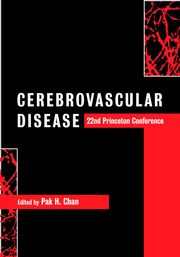Book contents
- Frontmatter
- Contents
- List of contributors
- Preface
- Acknowledgments
- Part I Special lectures
- Part II Oxidative stress
- Part III Apoptosis
- Part IV Hot topics
- Part V Hemorrhage, edema and secondary injury
- Part VI Inflammation
- Part VII Gene transfer and therapy
- Part VIII Neurogenesis and plasticity
- Part IX Magnetic resonance imaging in clinical stroke
- 28 Magnetic resonance imaging in stroke trials
- 29 Disappearing deficits and disappearing lesions: diffusion/perfusion MRI in transient ischemic attack and intra-arterial thrombolysis
- 30 Diffusion and perfusion magnetic resonance imaging in the evaluation of acute ischemic stroke
- 31 Early recanalization in acute ischemic stroke saves tissue at risk defined by stroke magnetic resonance imaging
- Part X Risk factors, clinical trials and new therapeutic horizons
- Index
- Plate section
30 - Diffusion and perfusion magnetic resonance imaging in the evaluation of acute ischemic stroke
from Part IX - Magnetic resonance imaging in clinical stroke
Published online by Cambridge University Press: 02 November 2009
- Frontmatter
- Contents
- List of contributors
- Preface
- Acknowledgments
- Part I Special lectures
- Part II Oxidative stress
- Part III Apoptosis
- Part IV Hot topics
- Part V Hemorrhage, edema and secondary injury
- Part VI Inflammation
- Part VII Gene transfer and therapy
- Part VIII Neurogenesis and plasticity
- Part IX Magnetic resonance imaging in clinical stroke
- 28 Magnetic resonance imaging in stroke trials
- 29 Disappearing deficits and disappearing lesions: diffusion/perfusion MRI in transient ischemic attack and intra-arterial thrombolysis
- 30 Diffusion and perfusion magnetic resonance imaging in the evaluation of acute ischemic stroke
- 31 Early recanalization in acute ischemic stroke saves tissue at risk defined by stroke magnetic resonance imaging
- Part X Risk factors, clinical trials and new therapeutic horizons
- Index
- Plate section
Summary
Introduction
Diffusion and perfusion imaging are playing a greater role in the clinical setting of acute ischemic stroke. These newer imaging techniques are already utilized in stroke diagnosis, and in the future may be used for prognosis and treatment triage. Diffusion-weighted imaging (DWI) has already been proven to sensitively show tissue injured by ischemic stroke early in the postictal state. Lesion volumes have been observed with DWI to enlarge over time after an acute stroke. Baird et al., Barber et al. and van Everdingen et al. reported that 43%, 44% and 41% of their respective patients showed increases in lesion volume after the first imaging time point. Recently there has been an emphasis on the combined use of perfusion-weighted imaging (PWI) and DWI in the acute stroke setting in the hope that they will help to define tissue at risk for injury. Several studies have shown that the perfusion deficit (measured as a prolonged mean transit time or time-to-peak delay) is initially larger in this acute setting. It appears that, in 70% to 80% of patients imaged within the first 6 hours of stroke, measured PWI deficits are greater than DWI deficits. In addition, this pattern where PWI> DWI is larger on the initial image has been shown to predict DWI expansion into the surrounding lesion.
- Type
- Chapter
- Information
- Cerebrovascular Disease22nd Princeton Conference, pp. 371 - 380Publisher: Cambridge University PressPrint publication year: 2002



